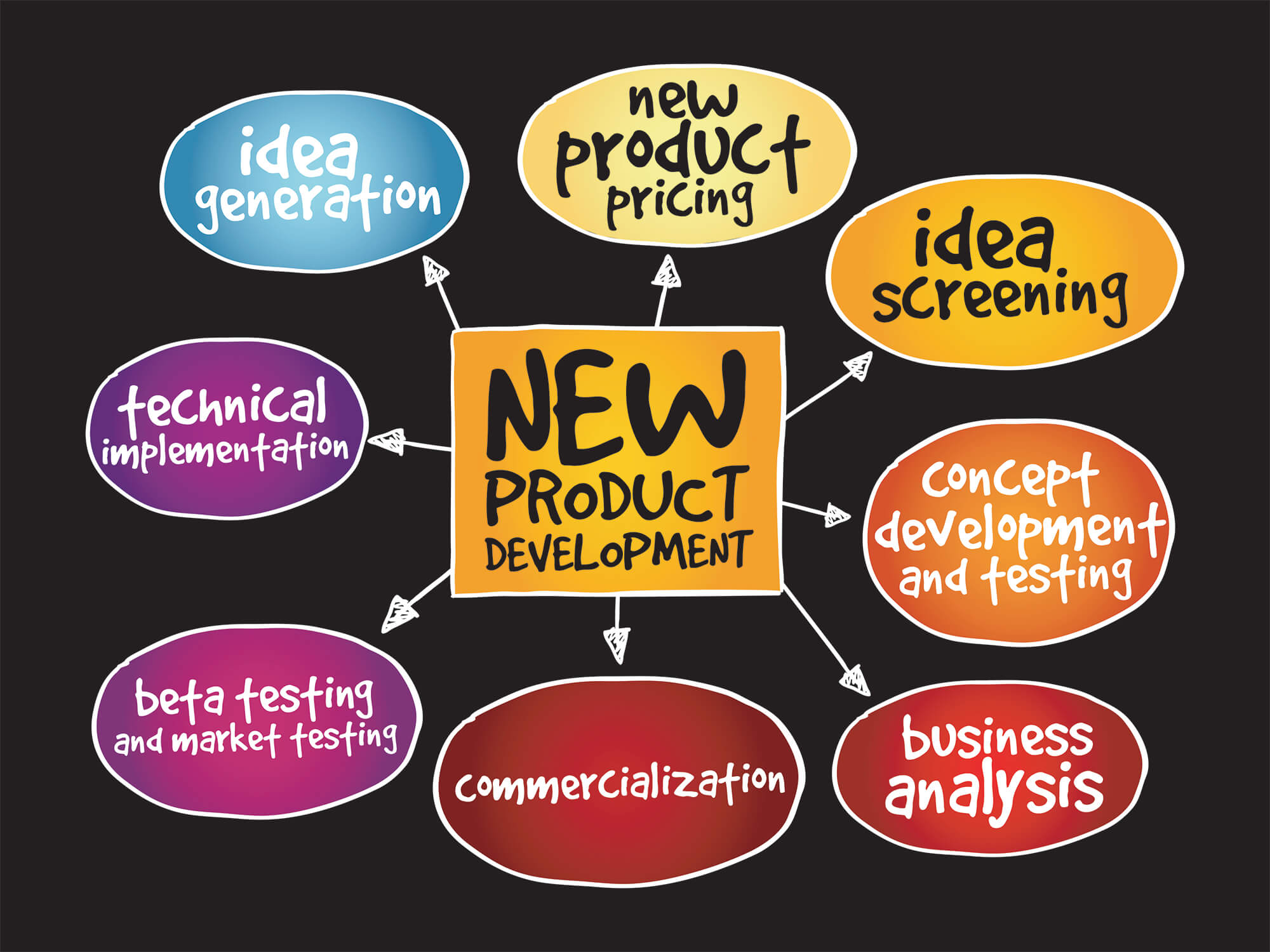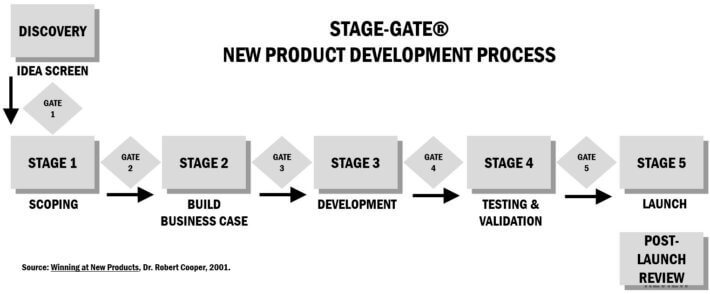12 Steps to a Powerful New Product Development Process (NPD Process)

Every large company has a system for new product growth. And yet, it’s often pushed aside, not understood, and taken for granted. Some view it as too technical. Some see it as complex. Most don’t recognize the potential energy it could release. What is this critical system? It’s the new product development process (or NPD process). The heart of the enterprise, hiding in plain sight.
Imagine that we renamed the NPD Process to be the “Profit-Generating Process” instead. Suddenly… it seems more interesting. After all, executives want investor meetings to be exciting. Celebrating wins is more fun than excusing losses.
And yet, it’s easy to forget the importance of the humble new product development process, the system that aligns the gears of the growth machine. Making the innovations, the growth, the profits – all possible. And yet, with so much at stake, and despite a thirst for new product success, company leaders spend little time here. By and large, they don’t understand the new product development process well. And so, they’re generally not involved with improving it.

How much attention does the new product development process merit?
Is it possible that executives don’t need to be familiar with the new product development process? Maybe the instinct to keep it at arm’s length is the right one. Maybe the process is the process; and there’s just not much to be done. Maybe ours is like theirs. Which is the same as everybody’s. Therefore, it presents no opportunity for competitive advantage. No more value in improving it, than say, there would be in improving HR policies or accounting templates.
But hang on. Peter Drucker reminded us that “Business has only two basic functions – marketing and innovation. All others are costs.” Not to disparage HR, but it happens to be part of the “all others.” Meanwhile, the new product development process is THE governance for innovation. What if... just what if… we could improve its effectiveness by 10%? What about 25%, 50%, or even 75%? What would the impact be?
On the other hand, what if the new product development process has been actually degrading over time? Say… getting 2% worse per year? What would the compounding impact be?
It’s time to better understand the new product development process
Clearly, for new product growth, leaders must be familiar with it. They should certainly… understand their company’s own system. And, they should know what “good” looks like.

In fairness, the new product development process isn’t taught within most MBA programs. It’s not a white-hot conference topic. We don’t have pieces on the Wall Street Journal’s front page. Or even the back page. There’s been little treatment within the Harvard Business Review. The business world at-large doesn’t even know who the NPD gurus are. Not in the same way it does Steve Jobs or Elon Musk.
And this is the good news. The world’s ignorance can be your advantage. Therefore, don’t despair if thinking, “Yikes! Actually, I don’t understand our new product development process myself!” Give yourself a break! Again, it’s not often taught or talked about. And so, let’s begin with a discussion of basics. What’s involved with a new product development process?
New Product Development process: The Basics
A new product development process is a system for bringing new products to market. It begins with customer discovery, followed by idea generation. It flows through various phases, concluding with product launch. To move from one phase to another, a project must pass through a “gate.”
At the gate, a project team presents their case during a “gate review”. At these reviews, a committee judges if it can proceed. There are many models for NPD processes, and every company has its own variant. However, Dr. Robert Cooper, founder of the Stage-Gate® system, produced the most common template.
DR. COOPER’S STAGE-GATE® NPD PROCESS
If looking across the new product development processes of many companies, you’ll find from five to nine stages. (Five or seven are most common). However, Dr. Cooper’s Stage-Gate® is the DNA within most. Therefore, to understand the new product development process, a great starting point is Stage-Gate® itself.

In his 2001 book, Winning at New Products, Dr. Cooper laid out the stages as follows:
Discovery: Pre-work designed to discover and uncover opportunities and generate ideas
Scoping: Quick, preliminary investigation of the project
Build the Business Case: Detailed investigation involving primary research – both market and technical – leading to a business case, including product and project definition, project justification, and a project plan
Development: Detailed design and development of the new product, and the design of the operations or production process
Testing and Validation: Trials in the marketplace, lab, with aims to verify and validate the proposed new product and its marketing and production/operations
Launch: Commercialization – full operations or production, marketing and selling
THE NPD PROCESS GATES
There’s a “gate” between each stage of the NPD process. The development team prepares and presents documentation at a “gate review.” At these reviews, the project may proceed to the next stage if approved. Or, it may be turned back for additional work. Alternatively, a project may be delayed or even canceled altogether. A gate-review committee will serve as judge, using preset criteria.
Why do companies need a new product development process?
Companies need a system for new product development because there are many functions to coordinate. Marketing, engineering, design, finance, manufacturing, public relations, and more. Lots of people involved. Lots of task dependencies.

Therefore, the advantage of having a process should be self-evident. However, here are some specific reasons:
Predictability: Checklists of items that each function group must accomplish, and by what date, ensures everything that should be done will be done.
Speed: Clarity keeps teams moving. They have a planning roadmap.
Objectivity: Established criteria removes emotion. Inspiring confidence.
Communication: Gate reviews are formal “check-ins” for leadership. It’s their opportunity to be informed. Additionally, leaders can ask questions, provide guidance, etc.
Continuous Improvement: As a defined process, the company can tweak over time.
Nobody will dispute the need for a new product development process. However, beyond that common ground, or perhaps because of it, companies are reliably poor at execution. It’s time that we stopped taking it for granted. It’s time to optimize the new product development process as the innovation engine that it should be.
12 Steps to Build a Powerful New Product Development Process
1. An executive should own the NPD process
This isn’t to say that a C-level person must be the one tinkering with it. Conducting reviews, etc. However, in reality, most are far too removed from it. This isn’t ideal. Executive-level oversight and familiarity, by itself, will elevate the process.

Who generally owns it in practice? Often, it’s an engineer or process pro. They’ll create presentations. Perhaps conduct training. Across the company culture, the NPD process can start to appear like just another engineering tool. When of course, it’s so much more.
However, to be realistic, maybe ownership doesn’t go all the way to the C-suite. Nonetheless, let’s elevate it as high as we dare. Let’s have the most senior person possible be responsible for the care and feeding of the new product development process.
2. The NPD Process should include Phase Zero (So that it doesn’t begin with an idea)
“Phase Zero” is almost a joke amongst innovation pros! Why is that? It’s because when a company created their initial new product development process, the first stage probably began with idea. Or maybe a product concept.
Eventually, a huge mistake became evident. The input should have been customer needs instead of a concept. But of course, by the time a company realizes this, they’ve already created their process, beginning with “Phase 1.” So, do they rename all the phases? Not normally! Instead, they just create a new one, “Phase Zero.”
Hopefully, your company has already corrected this. If not, begin there!
3. Scale the NPD process to the project (using risk assessments)
After adding Phase Zero, what’s the most common new product development process snafu? It’s failure to scale the process. “Scaling” means that early on, we examine all the tasks we might do. And then, we “scale out” a set of them.
That’s right. We decide what we’re not going to do. All projects are not equal in risk, investment, or strategic importance. Think about it this way, if you were going to walk a mile in your neighborhood, you wouldn’t need the same level of planning than if going to walk the Continental Divide Trail, from Canada to Mexico.

Moreover, a common complaint is that the process “takes too long”. There are several prime suspects for this. Failure to scale is one.
HOW DO WE DETERMINE WHAT TO SCALE OUT?
Begin the NPD process with a risk assessment. The riskier the project, the more tasks must be kept in. If bringing a totally new technology to a new market, you’ll include nearly everything. But what if you are taking a blue widget and just making it green? And then selling the green widget through your normal channels? In this case, then you can likely scale out many things.
Clearly, the team can go faster if it does less things. Speeding up the process. Bringing new products to market faster.
By the way, if your company does not have a risk assessment tool, consider AIM’s Minesweeper® software. Click here to learn more.
4. Challenge the document requirements of the NPD process
The advantage of scaling out tasks, as listed above, will accelerate new product development. Speeding up the process. However, consider this, some tasks should be removed altogether. As in, some shouldn’t be required for any project.
Just like with project “scope creep”, a new product development process is vulnerable to “requirement creep.” This happens because it’s easier to add requirements/tasks than it is to remove them.

Imagine that when your company’s NPD process was written in 1993, there was a requirement to “List customer benefits.” But then later, in 2018, your company wisely committed to New Product Blueprinting. As a result, you added the requirement to “List the customer’s desired outcomes” due to the new method. However, now your new product development process has two redundant tasks.
So, how does one get removed? In practice, this “feels risky” to the company. Especially when the redundancy may not be obvious. Continue this “requirement creep” for a couple decades, and the new product development process becomes unwieldy.
Therefore, on a continual basis, revisit the process. Cull out items as you can. Think like a minimalist. In particular, take a closer look when adopting sub-processes, such as New Product Blueprinting.
5. People run the NPD process, not the reverse
When executing the new product development process, two archetypes of people emerge. The first wants all the documents filled out perfectly, as if for a student project. The second is more interested just in what each stage should accomplish. Less concerned with checking every box.
It’s generally an advantage to have both perspectives and meet somewhere in-between. But not in the exact middle. The mentality should be closer to the second person. It’s better to focus on the broader purpose of each requirement. The spirit of the requirement is more important than “the letter of the law.”
Keep in mind that many systems are built on outdated processes such as QFD. In fact, most new product development processes conceived in the 1980’s or 1990’s were built using methods from Six Sigma. This wasn’t bad at the time, but there was a flaw in the heart of this well-intentioned idea: It presumed that an NPD process could have similar variance as a manufacturing process. Clearly, it will have more.
PEOPLE-POWERED FLEXIBILITY GETS THE BEST RESULTS
An effective new product development system must allow for variability. Unfortunately, the early NPD architects leaned a bit towards a simplistic view . That is, a simplistic view about how people actually produce great products.
For example, consider the creative process of adding features. Early processes handled it by assigning a task, such as “Execute an ideation session to generate features.” With this assignment, the team was supposed to schedule a 2-hour session, and then everyone would just suddenly be brilliant. You know, for those two hours. Creating the new features. This didn’t allow for the reality that people think of ideas all the time. Not just during the session. They might think of ideas while driving or in the shower.

That’s why it’s a mistake for the first archetype to dominate the execution. The new product development process isn’t the Magna Carta. It’s not the US Constitution. And it wasn’t handed down on stone tablets.
The people run the new product development process. Don’t let the NPD process run the people!
6. Adopt a common value proposition template
When new product development processes require many deliverables, why call out one in particular? Why mention the value proposition by name? Because it’s the most critical. The most important artifact of the NPD process.
The value proposition specifies the customer problems the new product will solve. In addition, it indicates how it will solve them. Further, it spells out the relevant competition.
Within the value proposition, everything comes together. More so than any other device of the new product development process. It’s critical to get it right. And you’ll want the power of a common template.
WHY A “COMMON” TEMPLATE?
Ideally, all the devices of a new product development process will be as “common” as possible. All of them. In fact, standardization itself provides advantages. There’s a reason that “standard work” is at the heart of lean manufacturing.

But why is it even more important for the value proposition? Two reasons. First, those on the gate review committee must quickly understand the value prop. It will help them to ask better questions. Better questions about the market, about customers, about competition. And of course, about the product. Additionally, this will be the most shared artifact across the company. For example, it’ll be used in promotional marketing – from PR to advertising. Also, it’s integral for training. Training of all types. Training for sales, distributors, call centers, etc.
So, spend a little time ensuring there’s a great value proposition template. There’s one based on jobs-to-be-done theory in Chapter 8 of Statue in the Stone: Decoding Customer Motivation with the 48 Laws of Jobs-to-be-Done Philosophy.
Additionally, you can download a Market Case sample, which demonstrates how to present a market case within the context of a presentation (using Blueprinter software) at www.marketcasesample.com.
7. Make gate reviews safe – for making hard decisions
As a professor at North Carolina State University, Mitzi Montoya, (currently the Dean of the School of Management at The University of New Mexico) performed an interesting research project. She assembled teams, pretending to guide a concept through a new product development process.
They were assigned an imaginary concept. The exercise was like a role-playing game. As it progressed, the teams made decisions about their project. The game was played in rounds. In each one, they were given a narrative about something that had changed. One narrative might be the results of a market research study. Another, about a competitive move. Another, a concept testing report. Some contained updates about technical challenges or advances.

Continuing on, students were to make recommendations. Recommendations about whether to continue the project or kill it.
Here’s what the students didn’t know about the narratives flowing in: they became progressively negative. All new information would continually present the case that the project should be halted. Starting as a whisper. Ultimately as a shout, “Turn back! This project must be stopped. It’s doomed to fail!”
AND SO, WHAT HAPPENED WITHIN THIS FICTIONAL NPD PROCESS?
The teams never quit. Never. They persevered. Always wanting to continue.
Consider this, if imaginary teams can’t kill their projects, how much harder will it be for real ones? When they’ve worked on the project for months? Or years? Also, how much harder will it be for leadership to stop the project, when the company has spent millions of dollars?
To be honest, projects shouldn’t be killed at a high rate once the new product development process has begun. However, it’s normal for changes to be made. Most commonly, launch dates need to be moved. Leadership is reliably guilty at pressuring teams to push ahead, to hit those launch targets. The cost of this pressure? Bad decisions. Resulting in bad outcomes, from culling out important features to setting the stage for quality issues.
The goal of a gate review isn’t to approve a project. It isn’t to kill a project. The objective is to review the work the team has done. It’s to listen to their recommendation. It’s to make the best decision.
8. Allow conditional acceptance at gate reviews
The original new product development process creators often framed gate reviews as primarily “go/no go” decision points. However, allowing for only those two doesn’t allow for real-world complexity.
“Complexity” means that the new product team will have members from nearly every business function: marketing, engineering, supply chain and operations. In a more advanced new product development process, the team will be even broader. With contributors from accounting, marketing communications, and perhaps more.

When the team arrives at a gate review, it’s likely that most functions have finished, but some activities may be lagging behind. In these cases, allow the team a conditional acceptance. Let the project pass with the condition that the additional requirements must be completed. In these circumstances, it can be helpful to later allow full approval via email, or with a special session. The NPD process must allow for this flexibility.
9. Ensure strong product management
Good product managers are critical. Consider that product managers are often called “mini-CEO’s”. Why is this? Because they have the most strategic role on the team. It’s their job to understand the market and competition. Ultimately, they’ll craft the value proposition. Therefore, within the team, they also should also have the last word on SKU and feature decisions.
Click here to learn more about building the product manager role within your B2B firm
Moreover, the product manager will be involved throughout all phases of the new product development process. Although, their activity level will not be equally divided amongst each. In the early NPD process phases, product managers are heavily involved with customer research, creation of product ideas/features, and specifications. Once development begins, they evaluate trade-offs between costs and benefits as issues emerge.
Along the way, the product manager will champion concept testing with customers. And finally, the product manager will be involved with training the broader organization, especially marketing communications, distributors and salespeople. By the way, how mature is your product manager organization? If you feel it needs some work, this PDMA article (Product Development and Management Association) is a good place to start.
10. Allocate resources with portfolio management
“Portfolio management” is the process of allocating investment resources. For a company counting on future returns, it must have a system to fund new product development projects.

Just like with any financial portfolio, this will include a diverse set of investments. “Low risk” projects will be upgrades, line extensions, and product refreshes – all targeting current markets. “High risk” projects could have any combination of potential hazards. Perhaps using new technologies or targeting adjacent markets. The newer something is to the company, the riskier the venture. Good portfolio management keeps the NPD process focused on corporate strategy.
HOW DO PORTFOLIO MANAGEMENT PROBLEMS FLOW INTO THE NEW PRODUCT DEVELOPMENT PROCESS?
A common complaint about the new product development process is that it’s “too slow.” That projects “get stuck”. Could this be an issue with the NPD process itself? Sure. However, it’s more likely that portfolio management is at the root.
If working well, portfolio management only funds a new project if resources are available. However, too often, the number of approved projects exceeds capacity. When this happens, all projects stall. For this reason, poor portfolio management will grind the new product development process to a halt.
By the way, as part of portfolio management, ensure that you’re using effective metrics. Measures that are predictive and precise. As a result, you’ll be able to better anticipate future growth. Click here to learn how to improve your innovation metrics.
11. Separate the portfolio management meeting from the gate reviews
Speaking of portfolio management, there’s naturally some overlap with the new product development process. For instance, in the early phases, an idea shouldn’t enter the system without available resources.
However, after this initial phase, keep the meetings for portfolio management and the new product development process separate. As much as you can. After all, they serve different purposes.
Portfolio management determines which projects to fund. It’s a strategic exercise. It gazes out years in the future. Good portfolio management takes many dynamics into account. Technologies, competitors, and your firm’s strategy. It’s explorational. Aspirational. Analytical. Additionally, it monitors the resource pool (including when new resources will come available).
Meanwhile, the new product development process manages execution. “Execution” of on-going, approved projects. It begins with the assumption that “we’re doing this project.”
12. Ensure the “lessons learned” session occurs
For any new product development process worth its salt, there’s an après launch task, the “lessons-learned” event. However, in practice, even the best of companies may skip it.
But why? For one, leaders are keenly interested in the launch. That’s good and to be expected. However, they likely don’t have the same enthusiasm for a process retrospective. And therefore, may be unmotivated to press the team for a debrief. Meanwhile, after launch (or even before), leaders waste no time distributing team members to other projects. And the team members themselves now have new pressing concerns.

Also, of course, a project probably had some missteps along the way. Mistakes. Errors. Problems. Moreover, nobody’s going to be motivated to re-assemble for an event that could make people look bad.
However, the lessons-learned event is important. We need to learn from our experiences. Make it a safe place. It’s about the process, not about the people. There’s rarely a decision that just a single person made anyway. The team shares in both glory and defeat. And afterward, it should debrief for the benefit of future projects. With a little discipline here, the NPD process itself will self-improve over time.
Where do we begin, to improve the new product development process?
The previous twelve steps should help you to get a sense of where to start. You’ll probably see areas to improve your new product development process. To go deeper, Stage-Gate® International maintains a complete library of resources on the topic You can find these by clicking here.
In particular, anyone responsible for the new product development process should have Dr. Cooper’s books Winning at New Products and Portfolio Management for New Products at a minimum.
However, while reading is one thing, to get the fastest results, it may be best to bring in an expert. In which case, you might contact Stage-Gate® International directly. They have a variety of services to get things moving, including an auditing process called Benchmarker™.
Improving the New Product Development Process is itself, a process.
With such obvious importance, why do companies not have more enthusiasm for improving the new product development process? Before going there, consider that companies also criminally underinvest in customer insight. Even though, new product failures invest less than half as much as compared to successful ones.

Possibly, it’s lack of knowledge, but more likely, it’s lack of patience. An investment in either customer insight or the new product development process pays off in the future. But of course, isn’t that the nature of any worthwhile investment, that it pays later?
Therefore, it’s actually not bad news that most companies fail to bolster their NPD process. Let it be your competitive advantage!
Five years ago was the best time to renew your new product development process, but the second-best time is today! Make sure you understand what you have now within NPD. Then go deeper with the resources listed here. Consider bringing in an expert. Your future employees, and current stockholders, will thank you.
Comments